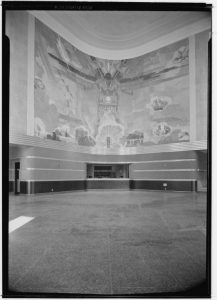My wife is always warning me that it can be dangerous to let a historian drive — they see something evocative along the roadway, and they might forget about the rest of the cars. As I drove home along Pico this past Monday, I was surprised to find this new billboard on the north side of the street, between Curson and Fairfax. No worries–I got over safely, parked at a meter, and snapped a few photographs.
This ad apparently reflects a new Chase campaign, at least for the LA area. Given the ubiquity of Chase and its national-chain competitors, I assume the message of the ad is intended to suggest that you might be tempted by credit unions, community banks, and others with good press in this moment of fees and bailouts, and the rest, but at the end of the day, what you really want is a bank you can find anywhere, anytime — and that is what Chase and their competitors have bet on.
But, in the context of the Home Savings banks’ place in the LA landscape, I think the choice of the Sunset and Vine location as backdrop is telling. My larger history about these banks is not just to map their locations and advocate for their preservation, but also to consider why Howard Ahmanson figured it was a good investment for his Home Savings and Loan banks to be icons, ornate works of art on landmark corners throughout Los Angeles.
The choice of a former Home Savings for the ad is the first use of the Home Savings properties in a Chase ad (as far as I know–know of others?), and it suggests a second, deeper sense of “easy to find” –not just a bank that would come up on your GPS as nearby, but a bank location that sticks out in your mind, as the Home Savings locations do.
I have yet to hear a firm commitment from Chase that they want to be the best possible stewards of the Millard Sheets and Associates art and architecture. But if it is good enough to use in an ad, can’t it be good enough to commit to preserving? That could be truly good news.
*
By the way, I have also come across fans of what was on the location of Sunset and Vine before the Home Savings — the NBC radio studios, an Art Deco building with a large, expressive mural welcoming visitors–much as Millard Sheets would design for Home Savings. Great photos, from construction to demolition, here.
Given the 1964 demolition date, it seems the building was torn down just as Home Savings went in — a question of cause or coincidence I will be researching soon.


Pingback: John Wallis and Associates: Home Savings Stained Glass from Installation to Repairs | The Cultural Civil War